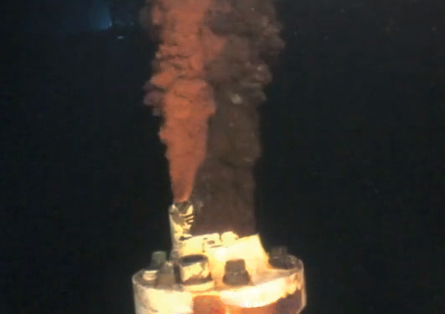
On September 19, petroleum engineers finally — and conclusively — plugged the BP well in the Gulf of Mexico. But before a temporary cap shut off the flow two months earlier, a new analysis estimates that some 4.4 million barrels of oil were released into the water — not counting about 800,000 barrels that were recovered as soon as they emerged.
This figure, the first independent estimate to appear in a peer-reviewed journal, exceeds slightly the 4.1-million-barrel calculation issued recently by a federal expert panel. Marine geophysicists Timothy Crone and Maya Tolstoy of Columbia University employed a novel optical technique to derive the estimate, which appears online September 23 in Science.
Initial estimates put the BP well’s daily release at 1,000 barrels — or 42,000 gallons. Over time, the Deepwater Horizon Unified Command, a mostly government consortium charged with spill management and cleanup, progressively revised that number upward to a range of between 53,000 and 62,000 barrels per day — closer to the higher figure at the beginning of the accident, when the well’s pressure was at its peak.
Based on two short video clips, the Columbia team’s estimates put flow at 56,000 barrels per day prior to June 3, when workers severed the wellhead’s riser pipe in preparation for placing a containment device on the leak, and 68,000 barrels per day afterward, plus or minus roughly 20 percent.
Crone and Tolstoy used an optical technique known as flow velocimetry. In this approach, the volume of a roiling plume is estimated by using video or a series of photos to measure the movements of a host of distinguishing features over a short period of time. Computers can then calculate likely flow volumes based on the plume’s size and density.
For roughly a decade, Crone has been tinkering with the general technique to gauge the flow of hydrothermal plumes jetting out of seafloor mounts. At remote mid-ocean ridges, optical measurements are the only techniques likely to work, he explains, because the scalding, mineral-rich plumes would melt or otherwise damage physical sensors.
In the lab, however, conventional flow-velocimetry techniques failed to give good estimates of known flow rates. So about three years ago, Crone developed an alternative that offered better accuracy. Instead of measuring the movements of individual spots in an imaged plume, his computer technique follows the swirling flows of bigger, cloudlike billows.
This past May, when he realized the first public video of oil emanating from the BP accident looked just like the roiling plumes jetting out of seafloor vents called black smokers, Crone requested high-resolution segments of the BP video. He and Tolstoy now offer flow estimates based on a 20-second — or 600-frame — video sequence captured on June 3 and a similarly small May 14 video snippet.
Their analyses, based on research funded by the National Science Foundation, illustrate how seemingly “lofty” geosciences studies can have real-world payoffs, Crone says. The frustration: “This technique could have been used on day one,” when BP was claiming its well’s flow was a mere 1,000 barrels per day. Imagine how spill-management activities might have changed, Crone says, if policy makers had been informed all along that flow rates were likely some 50 times that.
The new BP spill estimates are “based on a credible idea that has been used for 50 years in other areas of fluid mechanics,” notes Steven Wereley, a mechanical engineer at Purdue University in West Lafayette, Ind. However, he adds, “I don’t know of anyone besides [Crone] who uses his optical plume velocimetry.”
The calculations by Crone and Tolstoy “are in the realm of possibility,” Wereley says. He and other researchers estimated the slightly lower flow rates as part of the federally convened Flow Rate Technical Group. That panel employed optical velocimetry analyses of seafloor videos that were based on mapping and measuring the movements of particles in a plume, Wereley notes, “a much more widely used and scientifically vetted technique.”
Measuring the BP gusher from Science News on Vimeo.
Researchers used this video to analyze oil flow from the Deepwater Horizon well.
Credit: Courtesy U.S. Senate Committee on Environment and Public Works






